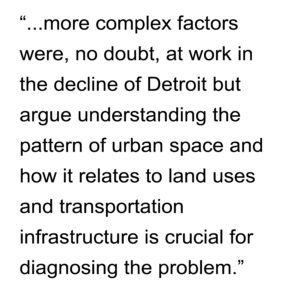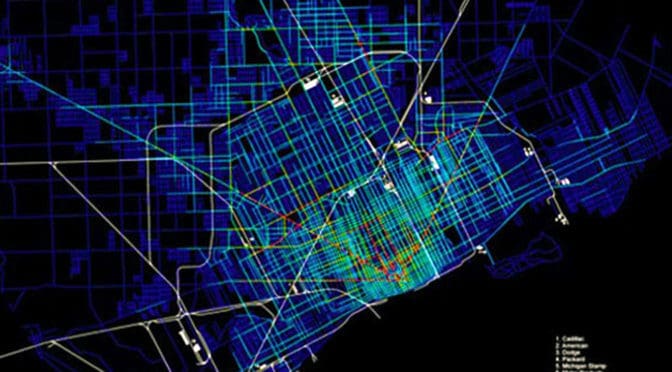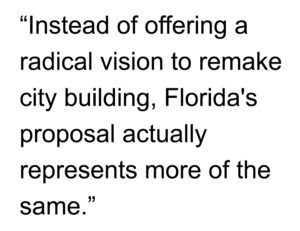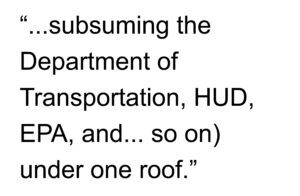Featured Image: Choice network analysis at radius 10,000 meters of Detroit in 1952 with industry superimposed from Paradigm lost, Industrial and post-industrial Detroit (Psarra et al, 2013).
REVIEW: Paradigm lost, Industrial and post-industrial Detroit by Sophia Psarra, Conrad Kickert, and Amanda Pluviano, Urban Design International, Advanced Online Publication, March 27, 2013
by Mark David Major, The Outlaw Urbanist contributor
There is a simple question at the heart of the Psarra et al paper, “Paradigm lost: Industrial and post-industrial Detroit – An analysis of the street network and its social and economic dimensions from 1796 to the present,” available as an advanced online publication from Urban Design International. This question is: can spatial pattern be implicated in the remarkable urban decline of Detroit over the last half-century? It is an important question precisely because so many architecture, urban design and planning professionals – as well as politicians and policy makers – never bother to ask it, especially in the United States. The answer provided by Psarra et al is an academically careful and qualified ‘yes’.
Their basic argument is the locating of large-scale industrial uses at the northern periphery of the urban grid (along and near to Davison St./Grand Ave.) beginning around 1900-1910 – in combination with interstate highway system construction and decline of the streetcar system a few decades later – served to disrupt the integrated functioning of the urban street network, commercial, industrial and residential land uses, and the transportation infrastructure serving them (railroads, streetcars) in the city. This facilitated radical decentralization of Detroit to the suburbs, where developers and industry could find ever larger and cheaper land parcels. Their argument is a little more nuanced than this but that is the gist. In doing so, they conclude (though don’t say so bluntly) the automobile both made and destroyed Detroit.
They acknowledge more complex factors were, no doubt, at work in the decline of Detroit but argue understanding the pattern of urban space and how it relates to land uses and transportation infrastructure is crucial for diagnosing the problem. In its diagnosis, the paper excels though it is very light on offering solutions (beyond a vague call for “radical solutions”).  For example, they generally discuss what they describe as “Landscape Urbanism” without much detail. They are far too kind to reveal what, I suspect, is probably an outright disdain for this approach to serious urban problems. Landscape Urbanism only exists because it is politically expedient and offers policy makers/politicians the appearance of doing something (and feeds the financial coffers of consultants) when, in fact, it is usually a useless solution that avoids the real problem all together. What is really interesting about their historical analysis is where industrial land uses were not located; namely, along the riverfront at the edge of the Woodward plan. This suggests the seeds of Detroit’s urban decline might be traced back to the early 19th century. Large-scale industrial land uses may not have been allowed to develop along the riverfront of the Woodward plan. If the industrial land uses along Davison/Grand had come to be located along the riverfront instead of the northern periphery, Detroit may have been better positioned to manage its transition from an industrial to a post-industrial city, as other cities have accomplished to varying degrees of success.
For example, they generally discuss what they describe as “Landscape Urbanism” without much detail. They are far too kind to reveal what, I suspect, is probably an outright disdain for this approach to serious urban problems. Landscape Urbanism only exists because it is politically expedient and offers policy makers/politicians the appearance of doing something (and feeds the financial coffers of consultants) when, in fact, it is usually a useless solution that avoids the real problem all together. What is really interesting about their historical analysis is where industrial land uses were not located; namely, along the riverfront at the edge of the Woodward plan. This suggests the seeds of Detroit’s urban decline might be traced back to the early 19th century. Large-scale industrial land uses may not have been allowed to develop along the riverfront of the Woodward plan. If the industrial land uses along Davison/Grand had come to be located along the riverfront instead of the northern periphery, Detroit may have been better positioned to manage its transition from an industrial to a post-industrial city, as other cities have accomplished to varying degrees of success.
By necessity, academic articles cannot cover all of the bases. For example, I would have liked to have seen spatial analysis of contemporary Detroit with its interstate highway system ‘peeled off’ to better reveal its disruptive effect on the underlying street grid pattern. I’m not even sure if current space syntax software allows for this kind of ‘alternative’ analysis. I would have also liked to have seen a spatial model of Detroit embedded within its larger urban context to the south in Canada (Windsor/LaSalle), where the railroad lines do terminate along the riverfront of the Detroit River. There is also the political factor. Detroit has been subject to one-party rule (Democratic) for the last half-century and it’s hard to believe this is only coincidental with its decline as an urban center. To excuse the Democratic Party from Detroit’s decline, one almost has to concede that all government policies are essentially useless (a very Libertarian position). However, there is only so much anyone can cover in an article. “Paradigm lost, Industrial and post-industrial Detroit” is well worth the read. At the very least, it will get you questioning the “conventional wisdom” in the field about Detroit and other cities experiencing similar problems.
You read the full article online or download a PDF via the link below:







 The circus of Senate confirmation hearings for the Secretary of Cities, brought to you by National Ready Mixed Concrete Association and Community Organizations International, just as soon as the Senator from Montana releases his hold on the nomination! Stay tuned! More pigs feeding at the Federal trough would inevitably populate Florida’s Department of Cities. That is fine for the pigs but what about the rest of us?
The circus of Senate confirmation hearings for the Secretary of Cities, brought to you by National Ready Mixed Concrete Association and Community Organizations International, just as soon as the Senator from Montana releases his hold on the nomination! Stay tuned! More pigs feeding at the Federal trough would inevitably populate Florida’s Department of Cities. That is fine for the pigs but what about the rest of us? The only way a Federal Department of Cities could alter the prevailing development paradigm in this country for the last century is if we are willing to place Smart Growth for our cities at the top of the agenda by subsuming the Department of Transportation, Department of Housing and Urban Development, Environmental Protection Agency, and other disparate Federal agencies and offices (Office of Urban Affairs, and so on) under one roof. Incidentally, this is probably the only way a new Department of Cities could generate bipartisan support by allowing the left and the right to explicitly address their key constituencies (urban interests on one hand, reducing and streamlining government on the other). It would also require both parties adopting an united front to take on other special interests threatened by such reform (most obviously, radical environmentalists). In the absence of such radical thinking, our cities are safer as “laboratories for pragmatic bipartisan policy innovation, pioneering new approaches on everything from schools, crime and gun control to economic development” at the local and State level.
The only way a Federal Department of Cities could alter the prevailing development paradigm in this country for the last century is if we are willing to place Smart Growth for our cities at the top of the agenda by subsuming the Department of Transportation, Department of Housing and Urban Development, Environmental Protection Agency, and other disparate Federal agencies and offices (Office of Urban Affairs, and so on) under one roof. Incidentally, this is probably the only way a new Department of Cities could generate bipartisan support by allowing the left and the right to explicitly address their key constituencies (urban interests on one hand, reducing and streamlining government on the other). It would also require both parties adopting an united front to take on other special interests threatened by such reform (most obviously, radical environmentalists). In the absence of such radical thinking, our cities are safer as “laboratories for pragmatic bipartisan policy innovation, pioneering new approaches on everything from schools, crime and gun control to economic development” at the local and State level. Why would we expect our citizens (and their representatives) to ever trust us and put us in charge when we have demonstratively failed our cities time and time again during their lifetime, their parents’ lifetime, and their grandparents’ lifetime? Instead of searching for magic bullets (like Florida’s idea), let us dedicate ourselves to leading for our cities. The irony is, if we truly did this, we would probably find the perceived need for Florida’s proposal and others like them would disappear. Unless, of course, the point is to become one of the fattest pigs at the trough. If this is the case, then never mind…
Why would we expect our citizens (and their representatives) to ever trust us and put us in charge when we have demonstratively failed our cities time and time again during their lifetime, their parents’ lifetime, and their grandparents’ lifetime? Instead of searching for magic bullets (like Florida’s idea), let us dedicate ourselves to leading for our cities. The irony is, if we truly did this, we would probably find the perceived need for Florida’s proposal and others like them would disappear. Unless, of course, the point is to become one of the fattest pigs at the trough. If this is the case, then never mind…